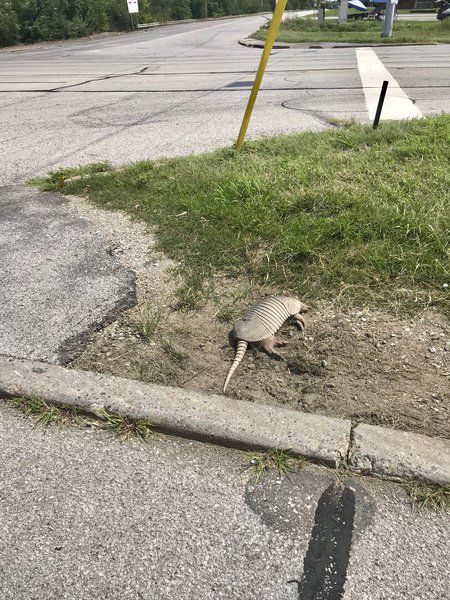Armadillos in Indiana rare, but they're here
Dead one found at U.S. 41 and Fort Harrison on Friday.
When a Tribune-Star delivery driver told Mick Siemers he saw a dead armadillo at U.S. 41 and Fort Harrison Road on Friday, Siemers was skeptical.
Siemers, the newspaper’s audience development director, has seen armadillos in the Southwest, but in Indiana? Terre Haute, Indiana?
“After I got done making fun of him for 15 minutes ... I assured him that on my lunch, I would drive down there,” Siemers said.
So he went, and sure enough, he saw the dead armadillo in a median.
“I was shocked,” he said, and he took a photo.
While armadillo sightings are rare in the Hoosier state, they are not unheard of John Whitaker, Indiana State University professor emeritus of biology, said Friday’s surprise represents the 20th sighting of an armadillo in Indiana, often in southwestern Indiana counties, over the past 10 to 15 years.
Those he’s documented have been found dead, although one located by a state conservation officer was still warm, he said. The northernmost sighting was in Parke County a few years ago.
Earlier this year, an Indianapolis television station reported that DNR officers in Pike County spotted an armadillo “wandering around.”
Whitaker has studied armadillos for several years and is documenting the Indiana sightings; he plans to publish a paper in the next few months.
The mammals, known for their unique, armor-like shell, have been spotted in Illinois since the mid-1990s, and armadillos are becoming more commonplace in Kentucky as well, according to media reports.
In each state, there have been more than 100 sightings, Whitaker said.
Whitaker suggests global warming might have something to do with it.
“We can’t prove it,” he said. But armadillos don’t do well in cold weather, and “they must be surviving ... a lot of things are moving north,” he said.
Indiana’s first confirmed armadillo report was about 15 years ago on I-64 just east of the Illinois line in Gibson County, but they’ve also been spotted in Warren, Daviess, Dubois and Pike counties.
The first one was “just this side of the Wabash River,” said Whitaker, who has studied the food habits of armadillos at Cumberland Island, Georgia.
Armadillos eat insects, including “a lot of ants,” as well as earthworms, and they are known for their burrowing habits. “They stick their noses in the ground and go through” searching for food, Whitaker said.
The mammals like wooded areas, where soil is soft so they can burrow through it; they prefer sandy soil, he said.
Armadillos can carry the bacteria responsible for leprosy. “I don’t think it’s anything to be concerned about, but I wouldn’t fool with them,” Whitaker said.
Purdue University wildlife specialist Brian MacGrowan said armadillos are more common in southern states, where it is a lot warmer.
“They don’t do well with frozen soil and cold temperatures,” he said.
Sightings in Indiana have been limited to warmer parts of the state, and in particular counties in southwest Indiana.
It’s unknown how they get here, MacGrowan said.
Jeff Thompson, a Department of Natural Resources wildlife biologist, said armadillos have slowly been migrating north over the last several years.
“We’re just starting to get more, as are other states in the Midwest.”
By Sue Loughlin Tribune-Star
Aug 10, 2018
